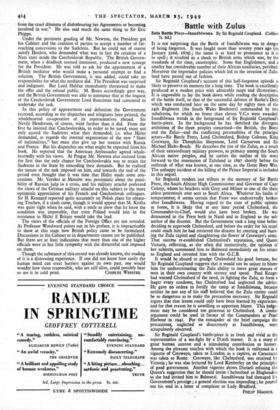Battle with Zulus
IT is not surprising that the Battle of Isandhlwana was in danger of being forgotten. It was fought more than seventy years ago (on
January 22nd, 1879) ; the name is as hard to pronounce as it is to spell ; it resulted in a shock to British arms which was, by the standards of the time, catastrophic. Some Boo Englishmen, and a smaller but considerable number of their African auxiliaries, perished. Moreover the imperialist policies which led to the invasion of Zulu- land have passed out of fashion.
Sir Reginald Coupland's account of this half-forgotten episode is likely to *serve its memory for a long time. The book is excellently produced at a modest price with admirable maps and illustrations.
It is impossible to lay the book down while reading the description of the battle itself, or that of the successful defence of Rorke's Drift which was conducted later on the same day by eighty men of the 24th Regiment (the South Wales Borderers) commanded by two subalterns, for which no fewer than eleven V.C.s were awarded.
Isandhlwana stands in the foreground of Sir Reginald Coupland's battle-piece. In the background he has sketched the divergent ambitions of the three peoples concerned—the British, the Boers and the Zulus—and the conflicting personalities of the principal actors—Sir Bartle Frere Lord Chelmsford, Bishop Colenso, King Cetewayo, Sir Theophilus Shepstone, Lord Carnarvon and Sir Michael Hicks-Beach. He describes the rise of the Zulus, as a result of their extraordinary military prowess, to primacy among the South African native peoples, and he carries the outline of his story forward to the annexation of Zululand in 1897 shortly before the outbreak of what was known, at one time, as the Great Boer War. The unhappy incident of the killing of the Prince Imperial is included in this sequel.
Sir Reginald renders just tribute to the memory of Sir Bartle Frere, the South African High Commissioner and Governor of Cape Colony, whom he brackets with Grey and Milner as one of the three
ablest proconsuls ever sent to South Africa. Whatever his faults of temperament, it seems certain that Frere was undeservedly broken
after Isandhlwana. Having regard to the state of public opinion at home, it is likely that at any later period Chelmsford, the Commander-in-Chief, would also have been broken. He was denounced in the Press both in Natal and in England as the sole author of the disaster. But the Government took a long time before deciding to supersede Chelmsford, and before the order for his recall could reach him he had retrieved the disaster by entering and burn- ing the Zulu capital and slaughtering the flower of Cetewayo's army. That success re-established Chelmsford's reputation, and Queen Victoria, reflecting, as she often did instinctively, die opinion of her subjects, summoned him to Balmoral immediately on his return to England and invested him with the G.C.B.
It would be absurd to grudge Chelmsford his good fortune, but Sir Reginald Coupland suggests that it would not be unjust to blame him for underestimating the Zulu ability to move great masses of men in their own country with secrecy and speed. Paul Kruger had warned Chelmsford of the need, in fighting the Zulu, to form a laager every sundown, but Chelmsford had neglected the advice.
He gave no orders to fortify the camp at Isamihlwana, because neither he nor any of his staff believed that the Zulu enemy could be so dangerous as to make the precaution necessary. Sir Reginald argues that that lesson could only have been learned by experience, and for that reason he is unwilling to apportion blame. This judge- ment may be considered too generous to Chelmsford. A similar argument could be used in favour of the Commanders at Pearl Harbour in 1941. For the remainder of the brief campaign the precautions, neglected so disastrously at Isandhlwana, were scrupulously observed.
Sir Reginald Coupland's battle-piece is as fresh and vivid as the representation of a sea-fight by a Datch master. It is a story of great human interest and a stimulating contribution to history.
Among the pleasant touches with which the book is enlivened is a vignette of Cetewayo, taken to London as a captive, as Caractacus was taken to Rome. Cetewayo, like Chelmsford, was received by Victoria ; he was also lectured by Lord Kimberley on the principles of good government. Another vignette shows Disraeli refusing the Queen's suggestion that he should invite Chelmsford to Hughendon as she had invited him to Balmoral. Isandhlwana had damaged his Government's prestige ; a general election was impending ; he poured out his soul in a letter of complaint to Lady Bradford.
PHILIP MAGNUS.














































 Previous page
Previous page